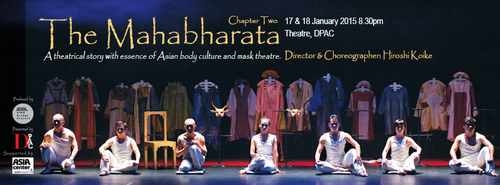A theatrical story with essences of Asian body culture and mask theatre?In finding common ground among the various Asian countries, Mahabharata is the most appropriate work, as it has the essence of Asian thought, philosophy and sensibility,? says Hiroshi Koike on the concept of the Mahabharata project.
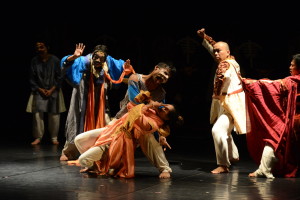 Theatre on War?? ?
Theatre on War?? ?
Venerable Japanese director and choreographer Hiroshi Koike is back in Malaysia having staged ?The Restaurant of Many Orders? in 2013. Koike is known for his unique blend of aesthetics and physical theatre, from the works of his former dance company Pappa Tarahumara to the Hiroshi Koike Bridge Project. In his latest play to hit DPAC, Koike comprehensively creates a theatrical story with essences of Asian body culture performed by various characters in Balinese masks. He will focus on the Vana Parya chapter of the Indian epic, starting from the game of dice to the end of the 13-year exile of Pandavas. The 18-member team of artistes hail from Japan, Malaysia, Thailand and India.
The Mahabharata Chapter Two will tour Malaysia to and Indonesia after its Indian premiere. Noted Butoh dancer Lee Swee Keong and lighting designer Loh Kok Man are the Malaysian representatives in the project. The four-part Mahabharata project was started in 2013 and supported by the Japan Foundation Asia Center.
Date: 17 & 18 January, 2015
Time: 8:30 p.m.
Admission: RM48/RM38
Dcard members: RM40/RM30
Venue: Theatre, Damansara Performing Arts Centre (DPAC)
Ticketing enquiries: www.dpac.com.my / 03 4065 0001, 03 4065 0002
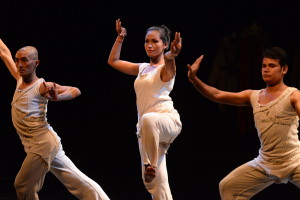 “Self-discovery through body expression” workshop
“Self-discovery through body expression” workshop
Conducted by Hiroshi Koike
Target audience: Theatre practitioners (suitable for all ages and abilities)
Koike has held workshops across the world for over 20 years. Based on his original “slow movement” programme, he teaches the skill of self-discovery. Through interactions with their own bodies, participants will discover unknown sides to themselves. They will also give a short performance at the end of the workshop.
Date: 18 January, 2015 (Sunday)
Time: 11:00 a.m. ?2:00 p.m.
Venue: Studio, DPAC
Fee: RM100
Workshop enquiries: ticketing.dpac@gmail.com / 03 4065 0001
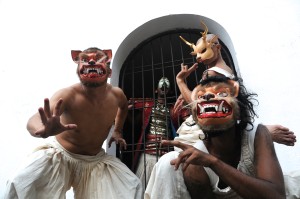 About The Mahabharata
About The Mahabharata
Mahabharata is an ancient Indian sacred epic written in Sanskrit. It comprises a total of 18 books and one hundred thousand poems, which makes Mahabharata 15 times as extensive as the Bible. In no other period or country can a comparably comprehensive epic can be found. For generations, it was respected as a foundational book for various topics, such as Indian religions, thought, cultures, philosophy, politics, law and etc.
Chapter 1 chronicles the beginning of the mythology and the conflict between the Kulu and Pandu families. Chapter 2 opens with the expulsion of the Pandu family to the forest. A long, terrible war over their territories erupts. This story has transcended the boundaries of time, religion and country. In today’s civilisation, it poses the question of what is human.
About The Mahabharata Project
It is a multi-year international project. This year, the project continues with chapter 2, which starts after the dice game.
Mahabharata is a very long story, so in many cases, only one part of the book is used. Hiroshi Koike’s version chooses to weave a yarn of humans, not gods. The first chapter is concerned with the background of the wars, the second chapter covers the wars, and the third chapter depicts the end of the wars. The abstract is mixed with the concrete in order to tell the whole story without using many words.
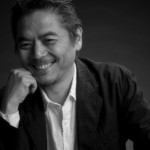 About Hiroshi Koike
About Hiroshi Koike
Director, Choreographer, Writer, Photographer and President of Performing Art Institute
A graduate of Hitotsubashi University, he started performing arts company Pappa Tarahumara in 1982. He has directed 55 pieces, toured 35 countries and worked with many artists internationally; establishing a high reputation throughout the world.
Koike has held many important posts in various committees, such as Artistic Director of Tsukuba Cultural Foundation (1997-2005), member of the Culture Promotion Committee of Aomori (1999), Chair of the Asian Performing Artists? Forum in Okinawa, and Specified Donation appointed member of Japan Foundation (2004-2011).
After the 2011 T?hoku earthquake and tsunami, he felt the need to change the paradigm and closed Pappa Tarahumara. In its place came the Hiroshi Koike Bridge Project. Through this new endeavour, he started international collaborations like the Mahabharata Project and Kenji Miyazawa Series. He has also published a book, “Listening to the Voice of the Body”.


